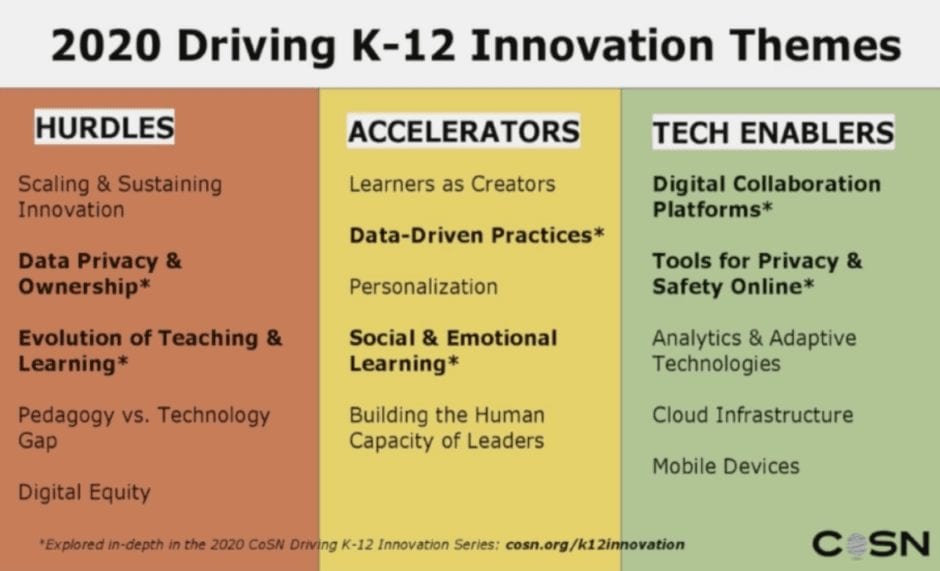Leading a District Effectively During an Unprecedented School Year
By Robert Low
Now that the 2020-21 school year is underway, district leaders must continue to respond in new ways to fast-changing situations resulting not just from COVID-19, but also from equity issues, and in many locations from environmental problems as well.
Key issues that district leaders are likely to face under these challenging circumstances were identified during an edWebinar, sponsored by ClassLink and co-hosted by CoSN and AASA, and important steps that administrators can take now were also explained. The panel members were Dr. Dan Domenech, Executive Director of AASA, The School Superintendents Association, Keith Krueger, CEO of CoSN (The Consortium for School Networking), and Dr. David Schuler, Superintendent of Township High School District 214 in Illinois.
With so many changes occurring at such a rapid rate, panel members recommended a focus on processes, metrics, and conversations that can help district leaders make good decisions and communicate effectively with their districts’ diverse stakeholders.
Top Priorities
Based on input from an AASA task force comprised of superintendents and state executives, Dr. Domenech identified key areas for leaders to focus on and highlighted some of the recommendations that had been made. The priorities included having multiple scenarios for school openings and closings, based on evolving CDC guidelines and COVID infection rates, and continued development of the district infrastructure needed to handle them.
A key element in any remote or hybrid scenario is equitable access to technology, and Dr. Domenech cited an estimate that as many as 14 million students still don’t have the equipment they need to receive an equitable education in areas where schools may be closed.
Also needed are trauma-informed and trauma-skilled schools so that teachers are prepared to work with students who may have experienced severe hardships as well as learning loss. Continued support for social, emotional, and psychological health needs to be available, and educators’ needs in regard to the latter two health areas also must be taken into consideration.
Human resources and staffing needs are also a top priority now, as some districts may not have enough qualified teachers if and when they return to in-school instruction. Meanwhile, many experienced teachers never taught remotely in the past, so they need ongoing training and support in order to provide effective instruction in remote and hybrid settings.
Anticipating COVID budget and financial management issues is also essential, as funding cuts have already become a huge issue for many districts. Returning to in-school instruction for all students will generate additional costs that many districts cannot currently afford.
Finally, district leaders also need to consider a new public education paradigm in which there is year-round schooling, funding is no longer based on in-school attendance, and the traditional teaching, learning, and assessment process is transformed into personalization, engagement, and differentiation.
Hurdles, Accelerators, and Tech Enablers
Krueger identified a series of overlapping challenges, trends, and potential solutions that have emerged from the current situation, which he sees as a pivot point that can lead to positive outcomes because innovation that may have been difficult to accomplish in the past is now required.
The major hurdles he identified include scaling and sustaining innovation, while also making sure districts are safeguarding data privacy and ownership and providing digital equity for diverse students. With an evolution of teaching and learning now underway, districts not only need to surmount the technology gap for students, but also the pedagogical technology gap that keeps some teachers from being effective online educators. At this point, “digital equity is not just a divide, it’s a chasm.”
Accelerators of positive trends can include data-driven practices that result in greater personalization of teaching and learning, as educators have student data more easily accessible and can use it in ways that help them differentiate their instruction. A continued emphasis on social-emotional learning will also help to engage students, thereby enabling them to make more academic progress while also developing life skills.
Technology enablers include improved analytics for teachers and adaptive technologies for students, and digital collaborative platforms that help students learn and work with each other, as well as with their teachers. There will also be an ongoing need for improved digital tools that provide privacy and safety online and further development of an online infrastructure that includes increased support for the use of mobile devices.
Krueger also emphasized the importance of effective conversations with all stakeholders, including consideration of who should participate, what forums and venues should be used, and how information should be distributed. And he pointed out that some students are actually thriving in remote settings, which can reduce behavior issues and result in more academic success, so educators can learn from those outcomes and use them to guide teaching and learning in the future.
Redefining School and Resetting Expectations
For Dr. Schuler, ongoing changes in public health guidelines and local infection rates have resulted in the creation of a range of scenarios with accompanying metrics, so there can be a widespread understanding of what will happen under which circumstances and why. This is especially important because his district, located in a Chicago suburb near O’Hare airport, has a diverse student population and circumstances vary in different neighborhoods.
One key decision the district made was not to try “to shoehorn last’s year’s curriculum” into the current situation, and instead reset and redefine what education will look like during the 2020-21 school year. This included changing the use of time during the school day in significant ways, so there are now just four block periods running from mid-morning to the end of the school day. There is also a designated time every morning for teacher preparation and collaboration.
This model is designed to work in any of the four scenarios the district has planned for: fully remote, partially remote, partially flexible, or fully flexible. And it is intended to make sure students have a high-quality educational experience no matter which scenario is in effect, or for how long.
Dr. Schuler said one of his most important learning experiences was realizing that some of his very best and most experienced teachers were dealing with significant anxiety and depression because they had expected to be as good at teaching remotely during the pandemic as they were at teaching in a classroom in the past. His response was to ask all of the teachers to forgive themselves, reset their expectations, and give themselves permission not to be perfect. He also asked the teachers to remember what it was like to be a year-one teacher, because this year every teacher is a year-one teacher.
This edWeb broadcast was sponsored by ClassLink and co-hosted by CoSN, AASA, and edWeb.net.
About the Presenters
Dr. Daniel A. Domenech has served as executive director of the American Association of School Administrators since July 2008. Daniel has more than 36 years of experience in public education, 27 of those years he served as a school superintendent. Prior to joining AASA, Daniel served as the senior vice president for National Urban Markets with McGraw-Hill Education. In this role, he was responsible for building strong relationships with large school districts nationwide. Prior to his position at McGraw-Hill, Daniel served for seven years as superintendent of the Fairfax County, VA, Public Schools, the 12th largest school system in the nation with 168,000 students. He earned a Bachelor of Arts degree from Hunter College in New York City and a Ph.D. from Hofstra University in Uniondale, N.Y.
Keith Krueger is CEO of CoSN (the Consortium for School Networking), a nonprofit serving as the voice of K-12 school system technology leaders. CoSN’s mission is empowering educational leaders to leverage technology to realize engaging learning environments. In 2016, Technology & Learning selected him as one of the “big 10” most influential people in edtech, and the Center for Digital Education identified him as a Top 30 Technologist/Transformer/Trailblazer. In 2008 he was selected by eSchool News as one of ten people who have had a profound impact on educational technology over the last decade. Keith has a global reputation as a key thought leader and has organized many senior-level United States delegations to visit Australia, Asia, Europe and South America to examine best practice in ICT in education. In fall of 2015, Keith conducted a Work Study on digital equity at Harvard’s Graduate School of Education.
Dr. David R. Schuler is the 2018 Illinois and National Superintendent of the Year. Known for his ability to inspire and build leaders, he spearheaded Redefining Ready!, the national movement to redefine what it means for students to be college, career and life ready while serving as the 2015-2016 President of AASA, The School Superintendents Association. Dr. Schuler leads High School District 214, Illinois’ largest high school district, where he led the development of an innovative instructional philosophy around personalized learning experiences focused on career pathways, early college credit, and industry credentials that enables students to discover their futures while still in high school. The 44 pathways align with the 16 national career clusters and students gain real-world experience through youth apprenticeships and workplace learning experiences. Dr. Schuler earned his bachelor’s degree from Carroll University and his master’s and doctoral degrees from the University of Wisconsin-Madison.
About the Host
Ann McMullan is Project Director for CoSN’s Empowered Superintendents Initiative. Ann served as Executive Director, Educational Technology in the Klein Independent School District, near Houston, Texas until September 2013, when she and her family moved to Los Angeles, California. For 16 years Ann led the district team that provided professional development on technology and 21st century instructional strategies to 4,000 professional educators serving 50,000 students. Ann served as co-chair of Texas Education Technology Advisory Committee which developed the Texas Long Range Plan for Technology, 2006-2020. Today, Ann is based in Los Angeles working as a public speaker, writer, and education consultant focused on leadership and planning to meet the needs of today’s students. Ann serves on the Project Tomorrow advisory council and is a leadership consultant with Executive Service Corps of Southern California, serving non-profit associations. Ann co-authored Life Lessons in Leadership, a guide for leaders ages eight to 88.
Join the Community
Super-Connected is a free professional learning community on edWeb.net for school superintendents, district leadership, and aspiring district leaders.



Robert Low has more than 30 years of educational publishing experience, ranging from editing and product management to online advertising and content development. He also works with edWeb.net to write articles on their professional learning edWebinars.





Comments are closed.